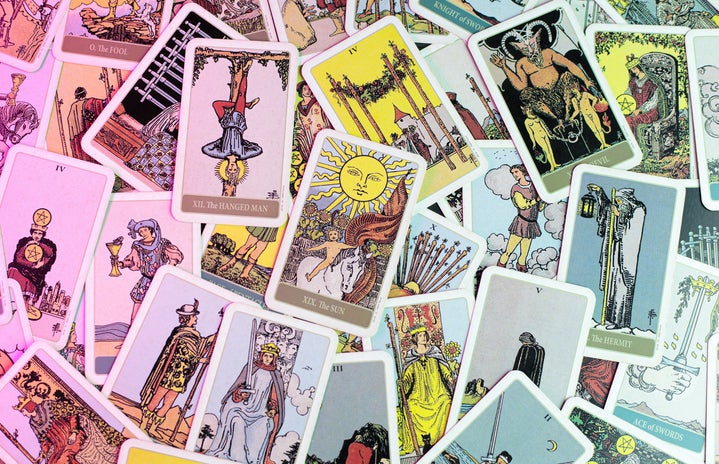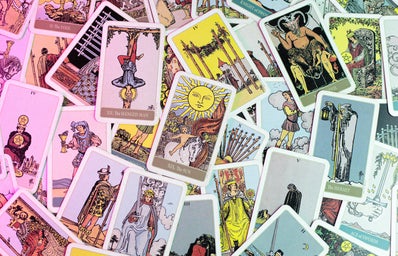Tarot cards can be an amazing tool that can offer insight into one’s life. What’s amazing about tarot is that you can use it for whatever purpose you want. Learning tarot can allow you to do readings on yourself or others. If you eventually become skilled in tarot, you can even turn it into a business venture by offering paid tarot readings to others. There are three important steps to take before you begin working with tarot cards. The first step is to find a deck that speaks to you, the second step is to learn your cards and the third step is to learn your spreads.
When it comes to tarot decks, there are many different unique spreads. Some decks take the original design, some use moon phases and some use other celestial bodies. The actual design of the tarot cards does not matter; what’s important is that it’s a design you enjoy, and you resonate with it. Because of this, I recommend always picking a deck in person (at least your first one). I use a deck called the Deviant Moon. I was able to pick up my deck in person at a voodoo shop in New Orleans. I stood in front of the great wall they had filled with many different tarot cards. I closed my eyes, walked to a random spot and placed my hand on the wall. Of course, there are more practical ways of finding a tarot deck that speaks to you, but I like to leave it up to chance and go wherever feels right.
The hardest part of starting tarot cards is learning the meanings of the cards. Don’t feel discouraged if you cannot memorize the meanings automatically; it takes time and patience. The most helpful tip I can give you is to start working on recognizing patterns between the imagery in the cards. For example, the devil card usually shows something with horns, and the lovers’ card usually depicts two beings that look happy together.
The main group of cards is called the Major Arcana. The Major Arcana cards are usually numbered from zero to 21. The cards are split into three groups: the material world, the intuitive mind and the realm of change. The material world is usually represented by cards zero through seven: the fool, the magician, the high priestess, the empress, the emperor, the hierophant, the lovers and the chariot. These cards deal with issues about the material world, like finances, successes and marriage. The intuitive mind is usually represented by cards eight through 14: strength, the hermit, the wheel of fortune, justice, the hanged man, death and temperance. These cards are based on emotions and are said to determine the needs of our hearts. The realm of change is usually represented by cards 15 through 21: the devil, the tower, the star, the moon, the sun, judgment and the world. These cards address life-changing circumstances and are used for finding one’s path in the world.
Besides the Major Arcana, there are other groups of cards within a deck that can help. The Suit of Pentacles are cards often associated with stability and wealth. These cards are best used to give financial insight. The Suit of Wands are cards often related to intuition. These cards give insight into how one communicates and how one expresses themselves creatively. The Suit of Swords are cards often associated with matters of conflict. These cards are used to give ethical advice or advice about conflict. The last group is the Suit of Cups. The Suit of Cups is often associated with relationships and emotions. These cards give insight into how one interacts with people in their daily lives, whether it is family, significant others or friendships.
The third part of learning tarot is the most fun: practicing. Practicing tarot cards means learning different spreads. A spread is a pattern in which you place your cards, and each place represents a certain aspect. Sometimes when you buy a tarot deck, an instruction packet will come with it, and within it will be a spread that you can do with the cards. If there isn’t an instruction packet or you don’t like the included spread, feel free to Google some new ones. You can do a spread that has as many as ten cards or as little as one card. Certain spreads are more useful for different types of questions. For example, a lunatic spread helps give an overview of the entire problem because there are ten cards involved, and they all work together to tell a complete story. In comparison, a three-card spread can give more insight into specific areas of the question like past, present and future. Once you find a couple of spreads that you find exciting, practice doing them until it starts to feel like second nature.
The best part of tarot is that there are no rules. If you only want to use one deck, then only use one deck. If you only want to practice one type of spread, then practice one type of spread. Whatever you feel works best for you is what you should do. Again, don’t feel discouraged if you do not automatically have a natural talent for tarot; you have to be patient and put in the work. Once you do get the hang of it, and you will, tarot can be an amazing tool that allows people to learn more about themselves and others.
Want to see more HCFSU? Be sure to like us on Facebook and follow us on Instagram, Twitter, TikTok, YouTube and Pinterest!



